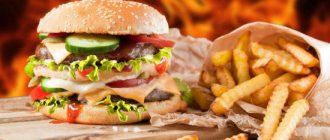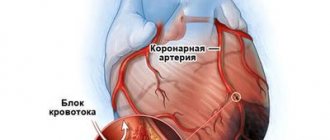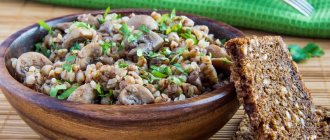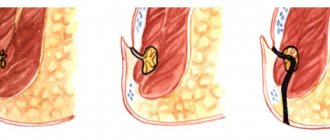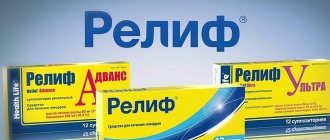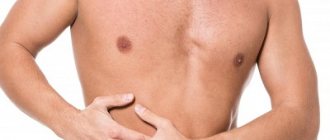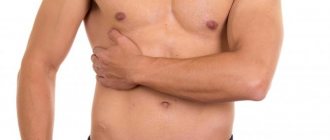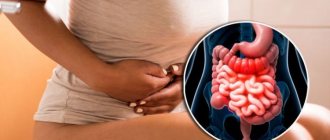Severe pain in the right hypochondrium, high body temperature, especially after eating high-calorie foods (fatty, spicy fried, smoked foods), constant weakness and other similar symptoms may indicate both an acute course of an inflammatory disease of the hepatobiliary system (cholecystitis, cholangitis), and rupture of the walls of the gallbladder.
This pathology can lead to death due to blood poisoning and peritonitis. If you consult a doctor in time, the course of treatment and subsequent recovery will take no more than 3 weeks.
In case of delay - six months or longer with further limitation of the functionality of the hepatobiliary system. In order to recognize the pathology in time, it is necessary to know its characteristic symptoms.
a brief description of
Rupture or perforation of the gallbladder is a perforating damage to its wall with subsequent penetration of bile into the intestines and or abdominal cavity.
There are 3 forms of pathology.
| Acute | Rejection of a large amount of bile into the abdominal cavity; pronounced symptoms; peritonitis as the main complication. |
| Subacute | Wave-like manifestation of symptoms; bile enters the abdominal cavity in unequal small portions; The main complication is blood poisoning. |
| Chronic | Bile enters the gastrointestinal tract through the fistula; into the gallbladder - bacteria and fungi; constant exacerbation of symptoms, acute or increasing in nature; complications - extensive inflammation, suppuration, necrosis, cirrhosis of the liver. |
Main diseases and anomalies of the gallbladder
Among the dysfunctions of the biliary system, much is associated with the failure of the organ due to unbalanced food intake or rare meals.
Cholelithiasis
Cholelithiasis or stones in the bladder are complemented by the appearance of growths in the pyriform organ or ducts. Among the main consequences of the appearance of cholelithiasis are excess cholesterol in the bile content, dyskinesia of the organ, which leads to stagnation, biliary hypertension due to a failure in the outflow of bile and infection.
Biliary dyskinesia
Dyskinesia or a failure in the contraction of an organ or ducts is observed due to an unbalanced diet with long breaks between meals, as well as under high loads on the central nervous system and psyche, and stress.
Cholecystitis
In 90% of patients with cholecystitis, the disease develops simultaneously with cholelithiasis, in which stones begin to disturb the walls of the pyriform organ, increase pressure inside the organ, and allow harmful microorganisms to enter, which provokes an inflammatory process and necrosis.
Cholangitis
Acute and chronic forms of this disease are caused by inflammation of the bile ducts. Typically, cholangitis appears as a complication of the main pathology, when infection or trauma during the movement of stones, operations provoke narrowing, the appearance of scars, and replacement of the main tissue of the tract with fibrous tissue. With the purulent and bacterial variety, the pain develops within several days and, in the absence of proper therapy, the person dies.
Cancerous tumors in the gallbladder
Cancer of this organ in 86% of cases appears as a consequence of chronic inflammation that affects the mucous membrane of the bladder and its pathways. The disease is caused by the early and rapid spread of metastases to nearby tissues and organs.
General symptoms
Nausea is one of the symptoms of pathology
There are symptoms that appear regardless of the form of the pathology.
- Nausea.
- Pain in the liver area.
- Changes in skin color.
- Temperature increase.
The intensity of the symptoms depends on the size of the rupture and the consistency of the bile (the higher the acidity of the bile, the clearer the symptoms with the corresponding form of the course).
A distinctive feature from liver pathologies and inflammation of the gallbladder is that symptoms intensify when consuming honey. From hepatitis - pain, unstable twitching, there may be tremors of the limbs.
“Difficult” bubble – what is it?
We are talking about a collective concept when, as a result of acute or chronic inflammation, infiltrative fibrous changes in the wall of the bladder occur, as a result of which tissue is scarred and the anatomy of the peri-vesical space is distorted, especially in the area of the neck and vesico-duodenal ligament. All this significantly complicates the operation and increases the risk of complications.
Difficulties in isolating tissues and the lack of familiar landmarks confuse the operator. He understands that the slightest inaccurate movement can lead to damage to important tubular structures and lead to severe, disabling complications. Special care is required and a different manner of dissection is required. This requires knowledge of the possible options for anatomy distorted by the inflammatory process, as well as knowledge of technical techniques that can help avoid unwanted complications.
“Difficult” gallbladder can be divided into two groups:
- acute inflammatory forms;
- chronic scar-fibrous changes in the gallbladder.
Acute inflammation of the gallbladder ranks second in frequency among all acute diseases of the abdominal organs after appendicitis. Its destructive forms develop in 30% of cases, especially in elderly patients.
Cases of peritonitis caused by destructive cholecystitis are not uncommon today, and mortality in such conditions can reach 30%. Surgeons see ways to reduce negative consequences in optimizing the timing of surgery .
It is well known that days 7-10 correspond in most cases to the stage of dense infiltration. Under these conditions, cholecystectomy may be accompanied by significant technical difficulties.
Based on vast experience and a large number of studies, the so-called “ACTIVE-WAITING” tactics for the treatment of acute cholecystitis.
The main provisions of this tactic were approved at the Plenum of the Board of the All-Union Society of Surgeons back in 1976. The most important thing is that this tactic, according to contemporaries, helped reduce postoperative mortality by 5-6 times due to a shift in surgical activity towards the “cold” period.
Despite the fact that anesthesia methods are constantly being improved, laparoscopic surgery has appeared, almost all operations have experienced a rebirth, this tactic is still used today in most emergency surgical hospitals.
The surgeon currently has 3 types of surgical interventions in his arsenal of methods for treating cholelithiasis:
- cholecystostomy;
- traditional cholecystectomy (“open”);
- laparoscopic cholecystectomy.
Symptoms according to the form of occurrence
There are characteristic symptoms for each form of pathology.
| Acute |
|
| Subacute |
|
| Chronic |
|
Symptoms of the acute form appear up to 1.5 hours. The nature of the symptoms is slowly subsiding - corrosion of the nerve endings at the site of damage.
Chronic - manifestations are provoked by: the entry of pathogenic microflora from the gastrointestinal tract, lifting weights, eating heavy food, increased bile acidity.
Watch the video for symptoms to watch out for:
Causes
The main reason is the movement of sharp-angled stones. Other:
- Injuries: blows - sudden release of bile - significant size of the rupture; intense or simultaneous unusual physical activity - heat, burning at the rupture site, as a rule, a longitudinal rupture of the correct shape; congenital pathologies - minor physical activity. Wearing a tight belt, bending over frequently.
- Long-term inflammatory processes - if there are scars or local thinning of the walls.
- Increased acidity of bile - multiple microcracks followed by perforation.
- Autoimmune diseases - gradual thinning of the walls - increase in temperature without other discomfort.
- As a result of unqualified abdominal surgery.
- Abuse of herbal decoctions for weight loss - thinning of the walls throughout the gallbladder - acute form - usually fatal.
- Immune diseases and or taking medications or folk remedies that wash macroelements out of the body and destroy proteins, including alcohol.
The symptoms of rupture or perforation of the gallbladder differ from cholecystitis and cholangitis in the following ways.
- The intensity of pain depends on food and fluid intake.
- The pain is uniform throughout the entire abdominal cavity, and in case of inflammatory diseases of the hepatobiliary system, it shoots into the stomach and right shoulder.
- Burning of soft tissues throughout the abdomen.
- The temperature rises instantly and practically does not drop, except for the NVP.
Is laparoscopic cholecystectomy a routine operation?
Laparoscopy
- Cost: 60,000 rub.
More details
Today, scientific interest in the treatment of gallstone disease has faded into second or even fourth place. Many problems have been solved, in particular in matters of surgical technique, mortality, complications, and rehabilitation periods have been reduced to a minimum. One might say that the cream of the big surgical topic has been skimmed off.
However, we must not forget that cholelithiasis remains one of the most common pathologies in our country and throughout the world. And a practical surgeon, including a young one, most often has to deal with gallbladder pathology. It is clear from this that the most common operation performed by surgeons of various qualifications is cholecystectomy.
It so happened historically that if previously a successful appendectomy was the “pass” to traditional surgery for a young specialist, then cholecystectomy was the “pass” for initiation into laparoscopic surgery.
Laparoscopic methods for the treatment of cholelithiasis are truly a well-known topic. Vast practical experience has been accumulated, and today it is difficult to surprise anyone with statistical reports.
Diagnostics
To make the results more accurate, you need to properly prepare for an ultrasound.
The chronic form is determined by the results of a general blood test - the indicator of nuclear rods above 25 is a sure sign of a fistula; then an ultrasound is performed according to the patient's complaints.
Complaints of pain in the right hypochondrium and nausea with an ESR of 20 or higher and leukocytes above 18 are reasons to do an ultrasound.
High ESR and leukocytes below 5 are an acute stage of an immune disease, and in combination with complaints of characteristic symptoms – a subacute stage with the course of sepsis.
To determine the pathology using instrumental methods, ultrasound is sufficient - the size of the rupture and or the multiplicity of perforation.
A biochemical blood test is needed to determine complications.
On palpation - sharp pain radiates to the kidneys and liver - involuntary holding of breath.
Treatment
Treatment is carried out in 4 stages.
- Preparation for surgery.
- Carrying out surgery to remove the gallbladder or suturing the damaged area.
- Elimination of inflammation or suppuration during the release or spontaneous circulation of bile.
- Treatment of complications or recovery.
Do not take vitamin C and avoid foods that contain it
Suturing the gallbladder is advisable only in case of perforation. In other cases - cholecystectomy.
Reduce inflammation with glucocorticosteroids. Exceptions are allergies and autoimmune diseases. In the latter case, non-steroidal anti-inflammatory and immunosuppressive drugs.
For peritonitis and sepsis, treatment is carried out with infusions, depending on the pathogen. More effective are 2-4 generation cephalosporins - a hepatoprotector with high regenerative ability (preferably with milk thistle), cyclophosphamide.
For recovery, do not use vitamin C; it is advisable to exclude citrus fruits, rosehip infusions, and berries for the first 2 weeks after surgery.
Why, in fact, about the old?
It is known that behind large volumes, as a rule, “traps” are hidden. There are situations when a seemingly simple intervention turns into a complex process with a possible serious outcome. This is due to pronounced scar-infiltrative changes that occur as a result of ongoing or previously suffered exacerbations of the disease.
A new galaxy of young surgeons is growing, for whom the topic of cholecystitis seems to have been resolved long ago. It is for them that it is necessary to return to the topic again and again. There is nothing more dangerous than a frivolous attitude before surgery. Everyone knows the wisdom: “you need to learn from other people’s mistakes,” but for some reason people still prefer to learn from their own...
We should not talk about “blue” blisters, but about complicated and insidious forms of this pathology. Today, experts are increasingly talking about the so-called “difficult” gallbladder.
Prevention
Do not wear a tight belt or tight clothing
If discomfort occurs in the liver area, do not self-medicate! This is especially true for traditional medicine - herbs sharply increase the acidity of the blood and bile. Do not abuse analgesics and antipyretics based on paracetamol and salicylic acid.
Do an abdominal ultrasound at least once a year. Not getting rid of bitterness in the mouth with sweets will result in a rapid increase in bile acidity. Do not use massage more than 3 times a week as a means of promoting stool. Do not resist the urge to defecate, accumulation of gases.
Do not resort to frequent vegetable and fruit diets. There should be meat in the diet once a day. Do not wear a tight belt or tight-fitting clothes. Do not take a contrast shower after physical activity.
Do not lift unusual weights - after lifting them, breathe often and deeply. This also applies to running long distances or at high speed without proper preparation.
Let the tightly fastened belt go slowly, breathe slowly. If there is a burning sensation or pulsation, stop until these feelings disappear.
